
Antietam National Battlefield in Sharpsburg, Md.
After the Old Hagerstown Pike passes the Miller farm on the right, the road takes a right-hand turn of almost ninety degrees and changes its name to Mansfield Drive — and there, the road begins to climb. It hops up one rise, flattens long enough to take a quick breath, then hops up another. There, it evens out a bit, and visitors to the north end of Antietam National Battlefield can finally begin to explore.
Several aluminum signs mark troop positions. On the right, a re-planted North Woods has begun to take root. On the left, on an ascending slope facing the road, the J. Poffenberger farm squats beside a white picket fence. Visitors come to a parking area, too, and the first of four granite monuments: the 8th Pennsylvania Reserves, then the 4th, the 3rd, and the 7th. Atop each monument, a stone sentinel looks southward.[1]
On the morning of September 17, 1862, the Pennsylvania Reserves watched as first one division and then another advanced southward into a cornfield owned by D. R. Miller. The fighting that took place there bloodied the ground so badly it capitalized the name in infamy: The Cornfield.
The Keystone men stood back in reserve, knowing their time would come — and indeed it did. In the meantime, Confederate artillery shells rained around them. They had to watch out for death from above even as they tried to watch the murderous fight in The Cornfield. “On this open field, in the corn beyond and in the woods which stretched forward into the broad fields, like a promontory into the ocean, were the hardest and deadliest struggles of the day,” a regimental historian wrote.[2]
The stone sentinels seem engrossed in the action, as though it’s still underway. The figure atop the monument for the 8th stands at attention, ready to answer the call to go in. The figure atop the 4th calmly loads his rifle and watches, his ramrod now long gone or invisible — but so transfixed is his gaze that he doesn’t notice his empty right hand where the ramrod should be. The figure atop the 3rd waves his hat: “Over here!” The figure atop the 7th, farthest down the line, also loads his weapon, also watches the fight.
All told, these four Pennsylvania Reserve regiments took some 222 casualties over the course of the three-hour fight — just a fraction of some 22,717 casualties suffered by both armies over the course of America’s bloodiest day. As though to remind us of that terrible toll, next to the monument for the 8th Pennsylvania Reserves sits a knife of white rock with a small red cross inlaid in its base. The red cross itself speaks volumes. A bronze tablet set into the rock’s face tells more: the story of Clara Barton, the nurse who came to the battlefield to tend to the wounded and whose acts of mercy and uncompromising vision led to a worldwide movement.
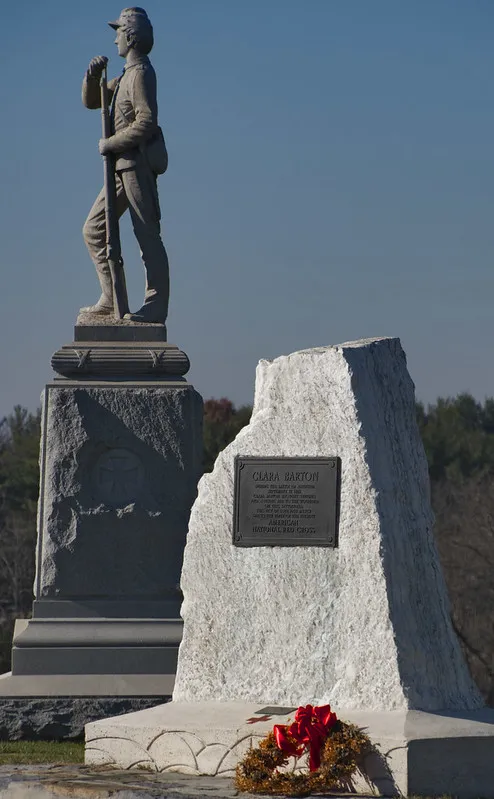
These monuments each share part of the story of what happened on this battlefield, and they challenge us, more than 160 years later, to bear witness to those stories.
“[T]he shafts and blocks of granite and marble that everywhere attract the vision of the visitor are, it is to be hoped, a proper suggestion, or so many sad reminders, of the hot contest that covered these hills and valleys . . .” wrote a veteran in 1908.
He was a one-time soldier from Illinois writing about the installation of monuments at Vicksburg — but he might have meant any battlefield.[3] At Antietam, one can see similar hills and valleys, as well as shafts and blocks of granite and marble, and knives of white rock, and silent stone sentinels.
“[B]attlefield monuments are melded to the historic sites where the heroic events occurred,” says historian Michael W. Panhorst, whose work has focused on the relationship between monuments and battlefields. “Monuments form a meaningful continuum between the past, present, and future.”[4] Monuments invite us, as battlefield visitors, to step into that continuum and engage with it—to listen, to learn, to consider, to find our own meaning. Monuments help ground us in story as we experience the power of place.
Commemoration, Documentation, Interpretation
The monuments on Civil War battlefields are as old as the battlefields themselves. In early September 1861, just one-and-a-half scant months after the first battle of Bull Run outside Manassas, Va., veterans of the 7th Georgia returned to the battlefield to erect a monument to their fallen commander, Col. Francis Bartow. “Boys, they have killed me, but never give up the field,” Bartow reportedly said. By returning to erect a stone shaft on the spot of Bartow’s death, the soldiers, in effect, carried out his orders in enduring fashion. Union troops, making their own return to the battlefield, later destroyed the monument, which was replaced in 1936 with a bronze plaque mounted on a rectangular block of granite. The remains of the original monument sit nearby between the trunks of two cedar trees.
In December 1861, forces clashed at Rowlett’s Station in Hart County, Ky. On the Federal side, Col. August Willich’s 32nd Indiana bore the brunt of the fighting. Survivors buried the dead near the battlefield and, in January 1862, erected a limestone monument to their fallen comrades. In 1867, the monument was moved to Cave Hill National Cemetery along with the remains of the men. The soft limestone monument didn’t hold up well over time, though, and by 2008, conservationists removed it for restoration and then put it on display in the Fraiser History Museum in Louisville while a replacement monument was installed at the cemetery. The 32nd’s monument is thus believed to be the oldest surviving Civil War monument, albeit not in its original location.
That distinction — remaining in its original location — belongs to the Hazen Monument on the Stones River Battlefield in Murfreesboro, Tenn. Col. William Hazen’s brigade held the line during the battle on December 31, 1862–January 2, 1863, suffering 55 casualties in doing so. The brigade buried its men on the field and, to mark their position and the position of the brigade in the battle, Hazen detailed a company of men between June and October 1863 to build a monument to them.[5]
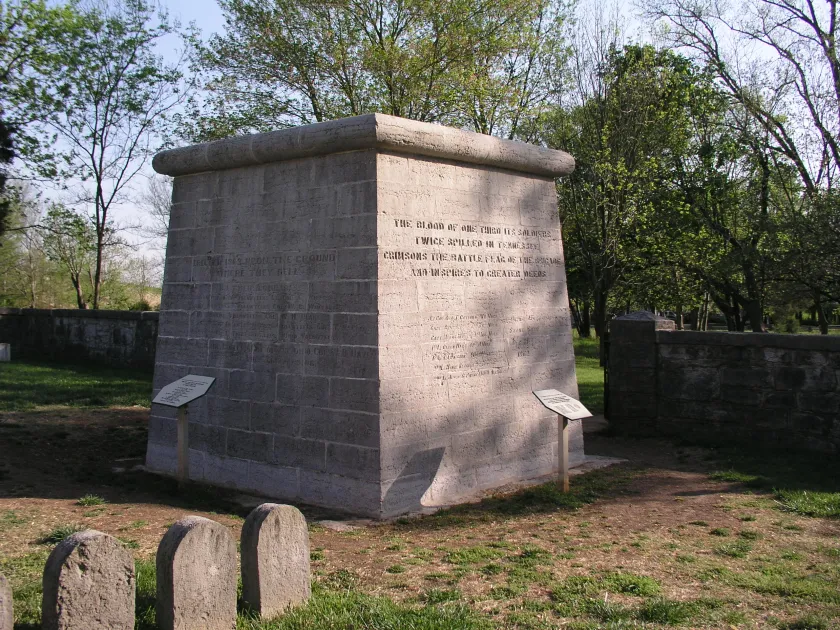
“The earliest monuments were meant to mark spots where soldiers were killed and/or buried,” explains Panhorst. “Thus, they are funereal in character, resembling obelisks, columns, and shafts erected in cemeteries at that time.”[6] Veterans saw the battlefields as literal hallowed ground.[7]
As Lincoln himself noted, brave men, living and dead, through their struggles, had consecrated it.
By the end of the war, the men began erecting other kinds of monuments and signs, says historian Timothy B. Smith, who has done extensive research on the history of battlefield preservation — not just to honor the dead but to mark significant events or special places on the battlefields.[8] Thus evolved, from the very earliest days of battlefield history, from the very men who fought on those fields, come the two main functions monuments serve on battlefields: to commemorate the men who fought there and to mark the events that took place there. “This dual duty of battlefield monuments doubles their impact and enhances the poignancy of these portrayals,” contends Panhorst.[9]
Ronald E. Lee, a National Park Service historian who spent much of his career studying the history of national military parks, identified a third purpose, related to the second: one had to be able to find the battlefields’ features to begin with. It’s perhaps hard for us to envision that today, as crowded as the modern world has become and as ubiquitous as GPS technology now is, but Lee reminds us that may Civil War battles were “fought in remote places, where pioneer farms were surrounded by wooded areas.”
In the nineteenth century, Lee said, “it seemed entirely possible, that with the passage of time the very identity of some important locations would become overgrown and lost even if the events themselves were not forgotten. One purpose of those who placed monuments on battlefields was to provide permanent identification for those historic locations.”[10]
This effort, explains Smith, would “offer future historians the best source of all in writing the various histories of the engagements.”[11] Battlefields themselves are a kind of primary source, of course; veterans saw their battlefield monuments as primary source material, too. Erecting monuments was like adding extra documentation to the landscape. Veterans undertook efforts to identify the locations of their various regiments so their own roles would be clear in the written histories. To mark those locations, they erected monuments—intended not only to commemorate their place on the battlefield but also document their place in history.
Knowing this, some groups “fudged” the placement of their monuments to give themselves premium placement on the battlefields and in the stories. For instance, at Spotsylvania Court House, the 15th New Jersey erected its monument at the very apex of the infamous “Bloody Angle” to denote the regiment’s role in the fighting on May 12, 1864. The monument puts the Garden State boys at the very center of the storm — even though they actually went into action about 200 yards to the west of that spot.[12]
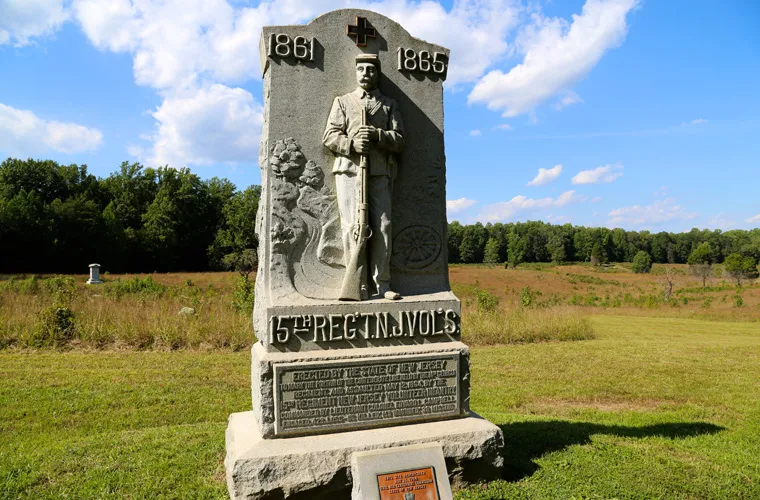
The most famous example is probably the monument erected by the 72nd Pennsylvanians at Gettysburg. Their placement of their stirring monument—topped by a Zouave-uniformed solider with his rifle butt raised high in the air as a club—suggests the regiment was embroiled in the thick of the fighting at the Confederate high water mark on July 3, 1863, as Pickett’s Charge penetrated the Federal line. The 72nd was ordered from their reserve position into the melee, but they refused to go, and only as action subsided did they finally advance. However, according to Gettysburg’s later monumentation rules, the regiment was allowed to erect its statue at the regiment’s point of farthest advance, stirring outrage from other regiments who knew the story of the 72nd’s reluctance. The case went all the way to the state Supreme Court, which decided in favor of the 72nd.[13] While the placement and design of their monument suggest more fighting than the regiment saw in one of the most-visited, most-storied sites on the battlefield, the 72nd also enjoys one other substantial perk: its placement silhouettes the monument against the sunset each night. With its action-posed soldier backdropped by brilliant day-end color, it’s one of the most photographed Civil War monuments anywhere.
Other monuments have been “misplaced” for more benign reasons. At Chancellorsville, the monument marking the wounding of Confederate general “Stonewall” Jackson was placed next to the Orange Plank Road not to mark the exact location of the shooting but for the convenience of passersby so they could see it from their carriages and know they were in proximity to the site.[14] At Fredericksburg, the Richmond, Fredericksburg, and Potomac Railroad erected the monument that became known as “the Meade Pyramid” so people on the train would know they were passing through the old battlefield.[15] While such monuments don’t mark the battlefields with exacting fidelity, they do raise awareness and help visitors engage with the landscape.
For this reason — engagement — monuments have become an especially vital interpretive tool for historians working on the battlefields. Monuments serve as tangible resources historians can point to as they explain the action, share stories, and connect visitors to the landscape.
Closely Connected with the Welfare of the Republic
The preservation and marking of historic battlefields was of such vital public purpose that the Supreme Court took up the matter in 1896. In the case of United States v. Gettysburg Electric Ry. Co., the unanimous court asked:
Can it [the government] not erect the monuments provided for by these acts of Congress, or even take possession of the field of battle, in the name and for the benefit of all the citizens of the country, for the present and for the future? Such a use seems necessarily not only a public use, but one so closely connected with the welfare of the republic itself as to be within the powers granted Congress by the constitution for the purpose of protecting and preserving the whole country.
Consider that for a moment: preserving and marking battlefields is “closely connected with the welfare of the republic itself.” The lessons of the Civil War needed to be enshrined for all citizens to learn from.
On April 30, 1864, the Pennsylvania legislature had captured that very spirit in the founding charter of the Gettysburg Battle-Field Memorial Association, the first public land effort to preserve and mark battlefield land. The legislation charged the group “to commemorate the great deeds of valor, endurance, and noble self-sacrifice, and to perpetuate the memory of the heroes, and the signal events, which render these battle-grounds illustrious” and “to hold and preserve . . . such memorial structures as a generous and patriotic people may aid to erect, to commemorate the heroic deeds the struggles, and the triumphs of their brave defenders.”[16]
Of course, William T. Sherman’s Atlanta Campaign and Ulysses S. Grant’s Overland Campaign got rolling just as the legislature passed its measure, so state and national attention was quickly diverted from preservation efforts. It was not until 1867 that preservation and memorialization at Gettysburg really got rolling, an effort that eventually led to the creation of Gettysburg National Military Park.
Gettysburg was one of the first five Congressionally approved military parks, receiving its charter in 1895. Chickamauga and Chattanooga was first, established in 1890, although Gettysburg’s preservation and monumentation efforts set a tone. “Chickamauga and Chattanooga and all subsequent national military parks were envisioned to have markers and monuments for both Union and Confederate forces,” says Panhorst.[17]
National park designations proved especially important and attractive to veterans, notes former NPS historian Donald C. Pfanz. “Placing their monuments in established parks not only assured that the stones would be widely seen by tourists but also that they would receive long-term care and protection,” he explains.[18]
States got in on the act, providing funding for thousands of state and regimental monuments and memorials, many designed and built by some of America’s best artists. “The states had recruited and financed regiments,” Panhorst explains, “so it was logical for each of the states to honor its own sons’ service. Because of the impact of the war, northern states generally erected earlier and larger memorials than southern states.”[19]
As Pfanz adds, “The defeated South had neither the means nor the motivation to erect memorials. By contrast, the North had both the money and the will to do so.”[20]
Pfanz says it’s no coincidence that the battlefields boasting the most monuments were Union victories. “Union veterans . . . preferred to erect monuments at places like Gettysburg, where they had achieved victory,” he says, pointing to the relative paucity of monuments in Fredericksburg and Spotsylvania National Military Park. “At Fredericksburg, Northern arms had suffered only stalemate and defeat.” Fredericksburg’s location in the South may have also played a role. “Union veterans may have feared that any monuments that they erected there might be subject to vandalism,” Pfanz adds. The park’s four battlefields — each a major engagement like Gettysburg — average fewer than 17 monuments per engagement.[21]
Richmond National Battlefield Park, which includes 13 sites that cover action from campaigns in 1862 and 1864, has only four monuments within its boundary. Only one of them was erected by veterans, a monument to Parker’s Battery that sits on a 10-acre plot south of Richmond. Another four monuments sit on property outside the park. Only one of those was erected by a veteran, too: Charles Storke, a member of the 36th Wisconsin who installed the monument “within feet” of where he’d been captured on July 1, 1864.[22]
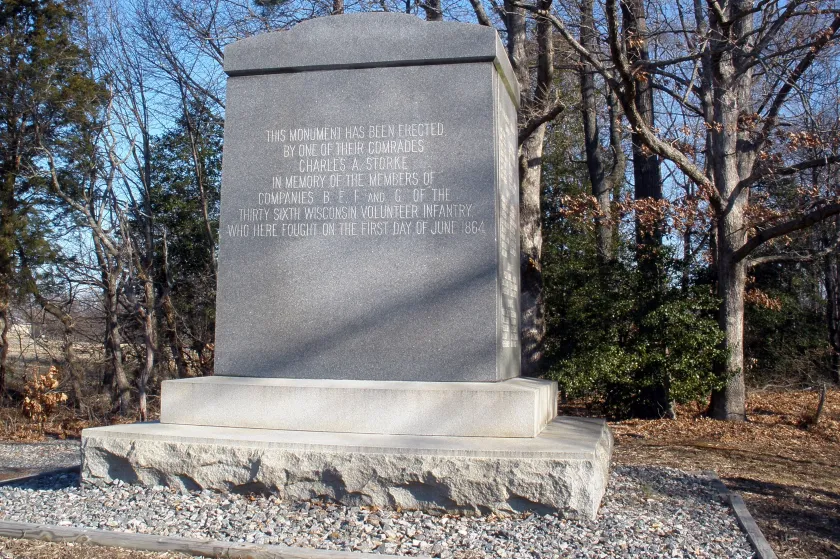
The disparity in monument placement from battlefield to battlefield actually does much to influence the individual character of each place. The pristine fields of Spotsylvania “feel” different than the similarly rural but more heavily monumented Antietam, which “feels” different than Shiloh. The sculpture garden that is Gettysburg — the largest collection of outdoor sculpture in the National Park Service — “feels” different than the similarly monumented but heavily wooded Chickamauga.[23] The variety of that visceral reaction is part of the veterans’ legacy.
Many Storytellers, Many Stories
Veterans wanted battlefields to be “reconciliatory items, object lessons, patriotic icons, and most of all, memorials to the living and the dead that fought in the war,” says Timothy Smith.[24] Their efforts to commemorate and mark through monumentation was an integral way to execute that vision, and it informed efforts by others as years unfolded.
For example, governor-appointed monument commissioners for the state of Tennessee urged the state legislature “to properly commemorate the heroism and devotion of the soldiers who gave their lives and sacrificed their health at the command of the State.” The commissioners petitioned for money “to erect suitable Monuments of Testimonials (sic) of a permanent form, showing the actions of those who made sacrifices. . . .”[25]
It was not until June 1996 before Tennessee erected a monument at Vicksburg, however. In the ensuing time period, as veterans began to die off, other groups took up the monumentation mantel: Sons of Union Veterans, Sons of Confederate Veterans, the United Daughters of the Confederacy, individual descendants, preservationists, admirers. Even states continued to erect monuments. In 2001, for example, Kentucky — which had men serve on both sides in the Civil War — dedicated an extensive memorial plaza between Union and Confederate lines at Vicksburg. In 2006, Vermont dedicated a huge granite monument in the Wilderness to commemorate the fighting there by the Vermont Brigade.
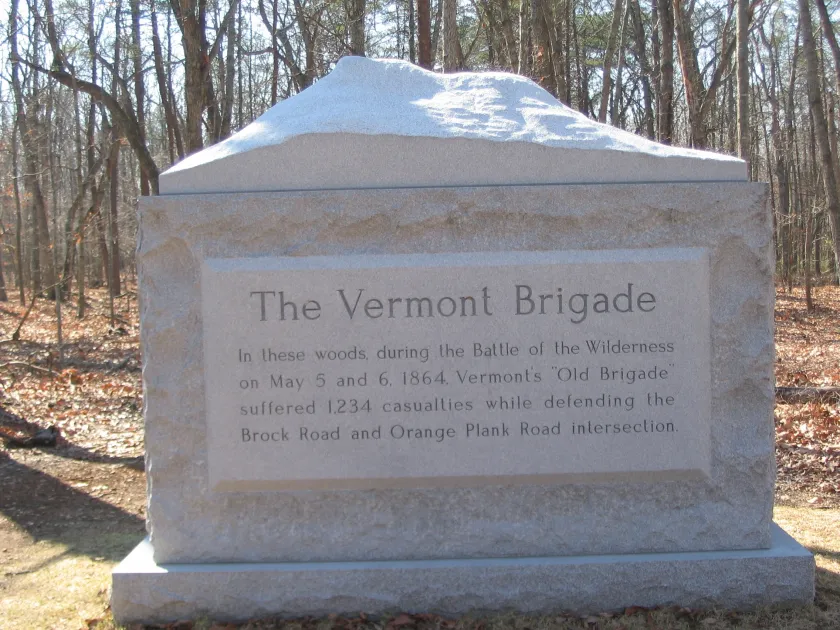
Over time, as veterans did more and more to mark the battlefields and their own places on them, the landscapes began to change.
The appearance of monuments on the first five battlefield parks, in particular, had a metaphorical — an almost spiritual — effect. It was, says Smith, like “restoring or recreating thousands upon thousands of soldiers on the battlefield…. The monuments were the reincarnated soldiers, honoring not only those still alive to place them, but also memorializing those who were killed on those exact spots.”[26] Today, the National Park Service recognizes that “the commemorative park built by battle veterans constitutes a third nationally significant landscape…. Over lain on the battle landscape, the avenues and monuments mark the lines of battle of the Union and Confederate troops.”[27]
Official National Park Service policy prohibits the approval of new commemorative works except where specifically authorized by legislation. “New monuments are intrusions on the historic commemorative landscape and diminish the integrity of the Battlefield Commemoration Area, and other historic resource areas,” the Park Service explains. “This policy applies to every historic commemorative area managed by NPS.” The policy provides only slight wiggle room: “[C]onsideration may be given to proposals that would commemorate groups that were not allowed to be recognized during the commemorative period.”[28]
This, of course, refers to such groups as United States Colored Troops (USCT), free and enslaved blacks, women, and other minority groups who had little political voice or financial means to support their own monumentation. “White Americans … began displaying unity while emphasizing the courage, bravery, and honor of Civil War soldiers with monuments, statues, and joint reunions,” says Smith, while the role of other groups was largely ignored.[29]
Fortunately, more attention is now being given to such stories. In 1998, for instance, the African American Civil War Memorial, managed by the NPS, was erected in Washington, D.C. In 2004, the state of Mississippi erected a $300,000 bronze-and-granite monument to African Americans at Vicksburg National Military Park.[30] As recently as the fall of 2021, an emancipation statue was dedicated in Richmond, Va., and a USCT monument was dedicated in Franklin, Tenn. As more attention comes to these neglected stories, the National Park Service will have more opportunity to help tell the ones integral to battlefields it manages.
Inspiration
The connection of battlefield monuments to the battlefields themselves is integral to their power and effectiveness. “Monuments enhance such sites, adding to the enjoyment and understanding of those who visit them,” argues Pfanz.[31]
Michael Panhorst offers an example. Consider, he suggests, the towering monument to the 1st Minnesota Infantry along Cemetery Ridge at Gettysburg. On the second day of battle, July 2, 1863, with Confederates surging, the Minnesotans charged into them. Of the 262 men who entered the maelstrom, only 47 returned. The 215 men who fell represented a staggering casualty rate of 82 percent.[32] “This statue by Jacob Felde,” says Panhorst, “depicting Minnesotans engaged in the action that earned them fame and glory — standing on the sacred ground where they displayed their selfless heroism — communicates the meaning of the memorial more effectively than a less site-specific composition, and more emphatically than the same sculpture installed in St. Paul or any other location.”[33]
Who does not stand at the foot of that monument and wonder about the figure atop it, charging forward at the ready, rifle in hand?
Who does not study the faces of the three men on the African American Monument at Vicksburg and not wonder what might be going through their minds in their moment of hardship?
Who does not perk up when they find a monument that unexpectedly features the name of their hometown?
These examples touch on a final purpose of monuments, beyond the original intentions of the veterans: Monuments can inspire. They can provoke thought and wonder. They can open us to empathy. They can challenge us and make us ask questions—not just about the history and memory they represent, but also about ourselves.
As I walk along Mansfield Avenue, my cowboy boots clicking on the pavement, I look up at each of the four stone men who are, themselves, looking into the distance. What do they see? What are they inviting me to see? I’m here, now, on this battlefield in this moment, but as I gaze at these monuments, I’m looking into the past and wondering about their future.
[1] Fun fact: All thirteen regiments of the Pennsylvania Reserves were on the field at Antietam, but only the regiments of Col. Albert Magilton’s brigade have monuments there. The rest of the regiments placed their monuments at Gettysburg. However, Magilton’s brigade was detached on garrison duty in Washington, D.C., during the Gettysburg Campaign and so missed the fight — and the opportunity to put their monuments there.
[2] Josiah Rhinehart Sypher, History of the Pennsylvania Reserve Corps (Lancaster, PA: Elias Barr & Co., 1865), 372.
[3] Charles Rudolph Edward Koch, ed., Illinois at Vicksburg; pub. under authority of an act of the forty-fifth General assembly (Chicago: Blakely Printing Company, 1908), 87. With thanks to Timothy B. Smith for pointing me in the direction of this resource.
[4] Michael W. Panhorst, “Lest We Forget: Memorial Art and Architecture on Civil War Battlefields,” Essential Civil War Curriculum, February 2016, 5, 7. https://www.essentialcivilwarcurriculum.com/assets/files/pdf/ECWC%20TOP…
[5] For more details, see https://www.nps.gov/places/hazen-brigade-monument.htm.
[6] Panhorst, 1-2.
[7] Timothy B. Smith, The Golden Age of Battlefield Preservation: The Decade of the 1890s and the Establishment of America’s First Five Military Parks (Knoxville, TN: University of Tennessee Press, 2008), 8.
[8] Timothy B. Smith, Altogether Fitting and Proper: Civil War Battlefield Preservation in History, Memory, and Policy, 1861-2015 (Knoxville, TN: University of Tennessee Press, 2017), xviii.
[9] Panhorst, 5.
[10] Ronald E. Lee, The Origins and Evolution of the National Military Park Idea (National Park Service, 1973). https://www.nps.gov/parkhistory/online_books/history_military/index.htm
[11] Smith, The Golden Age, 7.
[12] Donald C. Pfanz, History Through Eyes of Stone: A Survey of Civil War Monuments Near Fredericksburg, Virginia, unpublished manuscript, Fredericksburg and Spotsylvania National Military Park, 2006, 39.
[14] For more on this, see Chris Mackowski, “‘Roadside Attraction’ Jackson: The History of Stonewall Jackson’s Memorialization Around Chancellorsville is Deeply Rooted in Tourism,” Civil War Times, December 2019.
[15] Pfanz, 67-68.
[16] “An Act to Incorporate the Gettysburg Battle-Field Memorial Association,” Pennsylvania State Legislature, 30 April 1864. http://www.gdg.org/Research/Monuments/gbmahist.html.
[17] Panhorst, 2.
[18] Pfanz, 5.
[19] Panhorst, 1, 4.
[20] Pfanz, 5.
[21] Pfanz, 5.
[22] Bert Dunkerly, phone interview, 5 November 2021. Dunkerly is a historian at Richmond National Battlefield Park.
[23] “Policy for the Treatment of Monuments and Commemorative Era Resources: Gettysburg National Military Park (NMP) and the Soldiers’ National Cemetery (SNC),” Gettysburg National Military Park, May 2012, 2. Thanks to Gettysburg National Military Park historian Matt Atkinson for furnishing this source.
[24] Smith, The Golden Age, 9.
[25] From an un-bylined article in the Summer 1995 issue of Siege (Vicksburg, MS: Vicksburg Printing and Publishing Company), reprinting an article from the Summer 1990 issue of Siege, reporting on the decades-long delay of the Tennessee state memorial for Vicksburg. Thanks to Vicksburg National Military Park historian Andrew Miller for furnishing this source.
[26] Smith, Golden Age, 8, 9.
[27] “Policy for the Treatment of Monuments and Commemorative Era Resources: Gettysburg National Military Park,” 1.
[28] “Policy for the Treatment of Monuments and Commemorative Era Resources,”3; For NPS general policy, see pp. 140-141: https://www.nps.gov/orgs/1548/upload/ManagementPolicies2006.pdf
[29] Smith, The Golden Age, 5.
[31] Pfanz, 5.
[33] Panhorst, 5.






